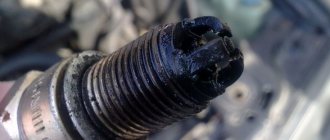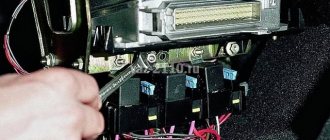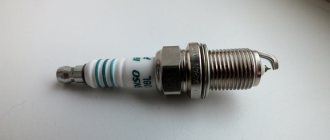There are many ways to diagnose the condition of a car engine. Among the most frequently used are computer diagnostics, compression measurement and others, but most of them require special equipment. However, there is a sign by which you can quite accurately determine how well the engine is working, without the use of additional tools - this is carbon deposits on the spark plugs. The appearance of a turned-out spark plug can tell a lot about the condition of the power unit and the correct operation of the auxiliary systems.
Why does a brown rim form on the spark plug insulator?
Most experts tend to agree: the plaque is caused by low-quality fuel, which is not distinguished by the purity of impurities and the absence of deposits. Such problems in gasoline cannot be determined with the naked eye or by smell, but by looking at the spark plug insulator after some time of operation, everything will become obvious. The brown spots themselves may differ in shade and structure; only after a qualitative examination of the part will it be possible to identify the exact causes of the suspicious excess.
How to clean spark plugs from carbon deposits
Since stable engine operation depends on the condition and performance of the spark plugs, these elements require care and require timely replacement. As mentioned above, during operation of the power unit, the spark plugs become covered with soot, deposits affect the quality of spark formation and impair the performance of the ignition system.
Taking into account the fact that the service life of spark plugs is limited for a number of natural reasons and strongly depends on the quality of the product, additional accumulation of carbon deposits leads to premature failure of these elements, melting of the electrode occurs, and other defects appear. This can be avoided by cleaning the spark plug from carbon deposits. This cleaning allows you to drive 5-15 thousand km longer with one set.
In order to clean spark plugs with your own hands at home or in the garage, you can use several available methods of mechanical and chemical cleaning.
- The easiest method for cleaning spark plugs is to remove carbon deposits using a wire brush and fine sandpaper. The advantage is simplicity and efficiency. In fact, the car owner manually removes the main contaminants with a brush, after which additional sanding is done with sandpaper. However, this method also has its drawbacks. First of all, after such cleaning, the spark plug insulator becomes covered with scratches, after which carbon deposits are deposited even faster. Also, excessive efforts during cleaning can lead to a violation of the gap between the electrodes, increasing the risk of electrode failure. For this reason, it is not recommended to use metal objects (screwdriver, awl, knife, etc.) to clean electrodes.
- Another method of mechanical cleaning is to remove carbon deposits using sandblasting. This solution is actively used at car service stations. Carbon deposits and deposits are removed using blown sand, after which additional blowing is carried out with compressed air from the compressor. This service has a low cost and allows you to thoroughly clean the spark plugs with minimal damage and scratches, and also saves the car owner’s time.
- In garage conditions, you can clamp the spark plug in the chuck of a reverse electric drill, after which, at speed, the spark plug is lowered into a container with sifted sand. This approach allows you to quickly clean the elements from heavy contamination. In some cases, spark plugs are also cleaned ultrasonically. The principle is similar to cleaning an injector in an ultrasonic bath; it combines the effects of ultrasonic waves and active chemistry. In this case, it should be taken into account that the specific nature of the contamination on the candles does not allow the most effective removal of carbon deposits and deposits using the specified method.
- With that said, many drivers prefer chemical cleaning to the method of physically removing carbon and deposits from spark plugs. In order to clean candles yourself, household chemicals are suitable. Some also use vinegar, heat candles in phosphoric acid or Coca-Cola, use silite, etc. Note that affordable products for removing rust and limescale have proven themselves to be the best. Such compositions are used for cleaning kitchen stoves, tiles, sinks, etc. Let's dwell on this decision. To remove dirt, you need to prepare a rag, a brush or a toothbrush, some water and a container convenient for use (a flat bowl, a shallow pan).
To clean spark plugs with detergent, follow these steps:
- The cleaner is poured into a pre-prepared container. You need to pour in such an amount that the candle is completely immersed in the cleaning composition;
- then the elements are soaked in the cleaner for about 30 minutes;
- after removal, remove any remaining deposits and carbon deposits with a brush or toothbrush;
- the final stage is rinsing in plain water, after which the candles are wiped with a rag as efficiently as possible;
Let us add that an important condition before installing it back into the engine is to dry the spark plugs. This can be done with a household hairdryer or place candles in the oven at a minimum heating temperature for 10-20 minutes, etc. It is not recommended to ignite spark plugs on gas or dry them with a hair dryer. The fact is that significant heating can lead to failure of the spark plug, cracking of the insulator and other defects.
The advantages of this cleaning method include simplicity, absence of mechanical damage, and the effectiveness of cleaning carbon deposits using household chemicals. Deposits are well cleaned from all elements of the spark plug and washed out of hard-to-reach areas. It turns out that such cleaning allows you to remove carbon deposits not only from the electrode, but also to remove deposits from the threaded part and insulator.
A worthy alternative is cleaning candles in a solution of ammonium acetate. For implementation, you will need water, a solution of ammonium acetate in water 20%, gasoline or carburetor cleaning fluid, and a brush with stiff bristles. You should also take into account that the candles will need to be heated in the solution, that is, you need a gas or electric stove.
The sedum itself involves the following actions:
- first, the spark plugs are washed in gasoline or cleaner, which allows them to be degreased;
- Then the elements are dried superficially. After this, the aqueous ammonium acetate solution is heated on the stove to 100 degrees Celsius or so;
Please note that you should not heat such a solution or work with ammonium acetate in closed, unventilated areas, as the vapors can be harmful to the body if inhaled. Before you start cleaning, you need to take special care of ventilation (open the windows, turn on the hood, etc.).
- then the spark plugs should be immersed in the hot solution for 30 minutes. During this time, the temperature of the solution should be maintained; slight boiling is allowed;
- upon completion, the spark plugs are removed, then they are cleaned using a brush;
- after this, the cleaned elements are rinsed in water and dried thoroughly;
Causes of carbon deposits on the spark plug insulator
The brown rim is divided into several colors, as well as the structure of the contamination. Based on this, you can accurately determine the faulty part of the car. A velvety dark shade indicates the penetration of the fuel mixture into the combustion chamber due to a clogged air filter.
Brown deposits on candles
A redder color means that the piston system caps or rings require replacement, in which case the oily liquid penetrates the combustion chamber, leaving a rim on the insulator over time. It is possible that the caps are unsuitable for connecting the mass to the igniters; these components must be periodically replaced.
Spark Plug Maintenance
If you have driven more than 30-40,000 kilometers on the same spark plugs, then even with a working ignition system, they will begin to act up. Plaque and iron oxide form on the electrodes, preventing the formation of a spark. In addition, when the metal burns out, it increases the distance between the electrodes, which complicates sparking.
Typically, spark plugs are replaced after long-term use, but in some cases their service life can be extended. To do this, just clean the contacts. But if you just clean the carbon deposits, the effect may be negative due to an increase in the gap between the electrodes.
You can restore the nominal gap by bending the upper electrode of the spark plug, monitoring it using a special probe.
Gap gauge
You should also pay attention to the condition of the insulators. If the insulator has cracks or other mechanical damage, the spark plug must be replaced. The presence of oil and dirt on the insulator is unacceptable. This reduces the effectiveness of the insulator, reducing resistance to electrical current. Its surface must be cleaned.
If the surface of the insulator is covered with an oil coating, then it is possible that the spark plugs are not screwed in tightly. They need to be unscrewed, the seats, contacts, insulators must be cleaned and screwed in again using a torque wrench. Table 1 shows torque values depending on the type of spark plugs and head material.
| Flat Fit Spark Plug (with Seal) | Tapered Fit Spark Plug | |||||
| Cylinder head material | Thread diameter | Thread diameter | ||||
| 18 mm | 14 mm | 12 mm | 10 mm | 18 mm | 14 mm | |
| Cast iron head | 35-45 Nm | 25-35 Nm | 15-25 Nm | 10-15 Nm | 20-30 Nm | 15-25 Nm |
| Aluminum head | 35-40 Nm | 25-30 Nm | 15-20 Nm | 10-12 Nm | 20-30 Nm | 10-20 Nm |
What does the formation of yellow carbon deposits on the spark plug insulator indicate?
Having seen spots of such a characteristic shade, drivers often encounter problems when starting the engine. The reason is the same low-quality fuel, only there is an increased presence of lead in the mixture due to the unscrupulous attitude of the gasoline supplier to the creation of its products. If you refuel with such fuel for a short time, then irreversible changes in the operation of the vehicle can be avoided; it’s another matter when the driver ignores the manifestation. In addition to problems with spark plugs, the car owner will face serious disruptions in the functioning of the entire power plant.
Red soot
If the fuel poured into the gas tank contains an excessive amount of additives, a red coating with a brick tint may appear on the device. Often the appearance of a red tint is caused by the fact that the additives contain metal. If such fuel is used regularly, then a deposit that conducts current occurs, which leads to interruptions in operation.
When a red tint appears, experts recommend changing gasoline.
Erosion
Erosion can also occur in a properly functioning mechanism. Parts often show slight signs of erosion.
In such cases, it is recommended to replace the damaged part or fuel.
Erosion occurs when the side electrode on the spark plug is bent excessively. With prolonged use, erosion causes failures. The engine may not start right away, malfunction after warming up, or stall.
White carbon deposits on the ignition system elements
The gradation of electrode colors from light gray to white (light yellow is also possible) is evidence that the engine is running on a lean mixture. Related reasons may be:
- The product is too hot. The heat rating of the product is lower than that recommended by the manufacturer.
- Large ignition timing angle.
- Using low octane gasoline.
There is no point in delaying in finding out the circumstances that caused this soot-colored condition on the new spark plug. A lean mixture directly causes overheating of both the igniter and the combustion chamber. Ultimately, this situation can lead to burnout of the exhaust valves.
Soot color - what does it indicate and what to do?
First, you need to carefully diagnose the devices; one or another shade of plaque can tell the motorist a lot, in particular, in this way you can detect weak points. Replacing elements on a carburetor or injector is not a problem, just like cleaning the spark plugs, the main thing is to understand what caused this condition. After all, if the problem is not solved in a timely manner, then the new candles will quickly deteriorate.
What color can carbon deposits on spark plugs be? Black, red or white. Any of these raids indicates that there are certain problems in the operation of the vehicle. Engine diagnostics using spark plugs often gives certain results, allowing you to identify the problem. Let's look at each of these colors.
Black soot
Plug with and without black deposits
Black deposits on spark plugs on a carburetor or injector can appear as a result of various problems. There can be two types of plaque - it can be either dry or oily. So why are spark plugs black?
Let's look at the main reasons for this condition:
- The carburetor is not working correctly, the device needs to be adjusted and cleaned.
- The air filter element is clogged. A replacement needs to be made.
- The pressure level in the fuel rail is too high.
- The spark energy is too low.
- Compression level too low.
If oil deposits form on the elements, then you need to make sure that the engine fluid does not enter the combustible mixture. As practice shows, the main reason in this case is wear of the oil scraper piston rings. In addition, damage to the valve caps can also cause plaque, as can be seen from the photo.
White plaque
Four spark plugs with white deposits
As for soot, it is white, as can be seen in the photo, but it can also appear for various reasons, especially since it can have several shades:
- Ash shade. In most cases, such deposits appear when you refuel your vehicle with low-quality fuel. It is quite possible to solve the cause of the problem with your own hands - just clean the elements and they can be used again. Of course, after this you should fill in with higher quality fuel.
- A shiny shade may be accompanied by erosion on the contacts. This condition indicates overheating of the components. As a rule, overheating occurs if the combustible mixture is slightly enriched. Also, the reason may lie in an incorrectly configured ignition (too early) or incorrect operation of the cooling system. As for overheating specifically, it can be quite dangerous, since over time it can lead to the formation of cracks and other damage, so if a shiny coating is detected, it is better to replace the parts.
Red and brown soot
Red-brown soot on the device
Brown or red soot on the spark plugs may indicate that the gasoline poured into the tank contains substances harmful to the engine or that the oil contains a large number of additives. If the shade is similar to the color of red brick, then this indicates that the car owner has been filling with leaded fuel for a long time. As a result of the fact that a brown coating appears on the ends of the spark plugs, the device will not be able to pass a spark. The only solution in this case is to clean the spark plugs.
The device may not produce a spark if its electrodes are clogged. You can try to clean the element, but most domestic drivers take the easier route - they simply change the SZ. Brown soot may have a yellow tint. If the coating is yellow, then this indicates a lean combustible mixture in the engine.
Other factors that indicate there is a problem
It's not just the color that can tell you that there are problems with the engine. For example, if you notice that erosion has formed on the electrodes, then most likely you are using low-quality gasoline, which has a high lead content. Poor clearance also contributes to erosion. Ash itself is an insulator; therefore, if its layer is too thick, then the required voltage will not be able to develop in the system. The appearance of ash is facilitated by the fact that the engine fluid does not burn completely in the engine cylinders, which is due to other problems associated with the piston rings.
As for motor fluid residues on the electrodes, they indicate failure of the valves or partitions; metal shavings may also be located on the electrodes.
In this case, the system is again filled with gasoline, which is why this happens:
- the system as a whole is not working properly;
- There were problems with the ignition.
If the vehicle is stationary for a long time, at the beginning of its operation the internal combustion engine may experience tripping, which disappears over time. In this case, blue-white smoke will come out of the muffler. In this case, the problem most likely lies in the cylinder temperature. Oil forms on the spark plugs when the spark plug itself is cold, or when there is a need to replace the oil caps or piston rings.
If the problem is not resolved in a timely manner, fuel consumption may double, and if the malfunction is related to the piston rings or partitions, then it will have to be solved in any case. And it’s better not to delay this moment!
Possible reasons for the appearance of soot
Before answering the question of why the candles are black, you need to decide how exactly they turned black . After all, it depends on which direction to search. In particular, the candles can turn black all together, or maybe only one or two of the set. Also, the candle may turn black only on one side, or perhaps along its entire diameter. There are also so-called “wet” and “dry” carbon deposits.
It should be noted that the speed of appearance and nature of carbon deposits directly depends on existing faults (if any):
- Carbon deposits on new spark plugs begin to form after at least 200-300 km. Moreover, it is advisable to drive along the highway at approximately the same speed and engine load. This way the spark plugs will work in optimal mode, and it will be possible to more objectively assess the condition of the car’s components.
- The amount and type of soot depends on the quality of the fuel used. Therefore, try to refuel at trusted gas stations, and not drive with gasoline or similar mixtures. Otherwise, it will be difficult to establish the real cause of the appearance of soot (if it occurs).
- In a carburetor engine, the idle speed must be set correctly.
Other types of damage and contamination
Mechanical damage to the electrode skirt can have several causes:
- Problems with the gas recirculation valve
- Inaccurate lead angle
- Unsuitable fuel type
- Excessive cooling
- Part failure
Sometimes the body has a reddish tint, but this may not be carbon deposits on the candles. Most often, the tint is caused by the fact that water gets on the engine and the part is simply covered with rust.
Rust may appear after washing, during bad weather, if the hood is insufficiently waterproofed. Experts most often recommend replacing the damaged part.











